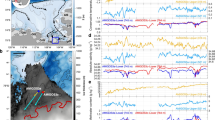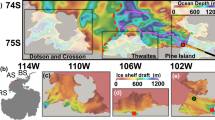Abstract
In 1994, ocean measurements near Antarctica’s Pine Island Glacier showed that the ice shelf buttressing the glacier was melting rapidly1. This melting was attributed to the presence of relatively warm, deep water on the Amundsen Sea continental shelf. Heat, salt and ice budgets along with ocean modelling provided steady-state calving and melting rates2,3. Subsequent satellite observations and modelling have indicated large system imbalances, including ice-shelf thinning and more intense melting, glacier acceleration and drainage basin drawdown4,5,6,7,8,9,10. Here we combine our earlier data with measurements taken in 2009 to show that the temperature and volume of deep water in Pine Island Bay have increased. Ocean transport and tracer calculations near the ice shelf reveal a rise in meltwater production by about 50% since 1994. The faster melting seems to result mainly from stronger sub-ice-shelf circulation, as thinning ice has increased the gap above an underlying submarine bank on which the glacier was formerly grounded11. We conclude that the basal melting has exceeded the increase in ice inflow, leading to the formation and enlargement of an inner cavity under the ice shelf within which sea water nearly 4 °C above freezing can now more readily access the grounding zone.
This is a preview of subscription content, access via your institution
Access options
Subscribe to this journal
Receive 12 print issues and online access
$259.00 per year
only $21.58 per issue
Buy this article
- Purchase on Springer Link
- Instant access to full article PDF
Prices may be subject to local taxes which are calculated during checkout




Similar content being viewed by others
Change history
29 June 2011
In the version of this Letter originally published online, Fig. 4b–d were incorrectly described in the caption. This error has now been corrected in all versions of the Letter.
References
Jacobs, S. S., Hellmer, H. H. & Jenkins, A. Antarctic ice sheet melting in the southeast Pacific. Geophys. Res. Lett. 23, 957–960 (1996).
Jenkins, A. et al. Glaciological and oceanographic evidence of high melt rates beneath Pine Island Glacier, West Antarctica. J. Glaciol. 43, 114–121 (1997).
Hellmer, H. H., Jacobs, S. S. & Jenkins, A. in Ocean Erosion of a Fast-Moving Antarctic Glacier in the Amundsen Sea 83–99 (Ant. Res. Ser., 75, AGU, 1998).
Rignot, E. Fast recession of a West Antarctic glacier. Science 281, 549–551 (1998).
Shepherd, A., Wingham, D. J., Mansley, J. A. D. & Corr, H. F. J. Inland thinning of Pine Island Glacier, West Antarctica. Science 291, 862–864 (2001).
Joughin, I., Rignot, E., Rosanova, C. E., Lucchitta, B. K. & Bohlander, J. Timing of recent accelerations of Pine Island Glacier, Antarctica. Geophys. Res. Lett. 30, 1706 (2003).
Shepherd, A., Wingham, D. J. & Rignot, E. Warm ocean is eroding West Antarctic Ice Sheet. Geophys. Res. Lett. 31, L23402 (2004).
Payne, A. et al. Numerical modeling of ocean–ice interactions under Pine Island Bay’s ice shelf. J. Geophys. Res. 112, C10019 (2007).
Rignot, E. Changes in West Antarctic ice stream dynamics observed with ALOS PALSAR data. Geophys. Res. Lett. 35, L12505 (2008).
Wingham, D. J., Wallis, D. W. & Shepherd, A. Spatial and temporal evolution of Pine Island Glacier thinning, 1995–2006. Geophys. Res. Lett. 36, L17501 (2009).
Jenkins, A. et al. Observations beneath Pine Island Glacier in West Antarctica and implications for its retreat. Nature Geosci. 3, 468–472 (2010).
Dinniman, M. S., Klinck, J. M. & Smith, W. O. Jr Cross-shelf exchange in a model of the Ross Sea circulation and biogeochemistry. Deep-Sea Res. II 50, 3103–3120 (2003).
Walker, D. P. et al. Oceanic heat transport onto the Amundsen Sea shelf through a submarine glacial trough. Geophys. Res. Lett. 34, L02602 (2007).
Thoma, M., Jenkins, A., Holland, D. M. & Jacobs, S. S. Modelling Circumpolar Deep Water intrusions on the Amundsen Sea continental shelf, Antarctica. Geophys. Res. Lett. 35, L18602 (2008).
Gade, H. G. Melting of ice in seawater: A primitive model with application to the Antarctic ice shelf and icebergs. J. Phys. Oceanogr. 9, 189–198 (1979).
Jacobs, S. S., Huppert, H. E., Holdsworth, G. & Drewry, D. J. Thermohaline steps induced by melting of the Erebus Glacier Tongue. J. Geophys. Res. 86, 6547–6555 (1981).
Jenkins, A. & Jacobs, S. S. Circulation and melting beneath George VI Ice Shelf, Antarctica. J. Geophys. Res. 113, C04013 (2008).
Joughin, I., Smith, B. E. & Holland, D. M. Sensitivity of 21st century sea level to ocean-induced thinning of Pine Island Glacier, Antarctica. Geophys. Res. Lett. 37, L20502 (2010).
Holland, P. R., Jenkins, A. & Holland, D. M. The response of ice-shelf basal melting to variation in ocean temperature. J. Clim. 21, 2558–2572 (2008).
Little, C. M., Gnanadesikan, A. & Oppenheimer, M. How ice shelf morphology controls basal melting. J. Geophys. Res. 114, C12007 (2009).
MacAyeal, D. R. Thermohaline circulation below the Ross Ice Shelf: A consequence of tidally induced vertical mixing and basal melting. J. Geophys. Res. 89, 597–606 (1984).
Jenkins, A. The impact of melting ice on ocean waters. J. Phys. Oceanogr. 29, 2370–2381 (1999).
Wunsch, C. The North Atlantic general circulation west of 50° W determined by inverse methods. Rev. Geophys. Space Phys. 16, 583–620 (1978).
Nitsche, F. O., Jacobs, S. S., Larter, R. D. & Gohl, K. Bathymetry of the Amundsen Sea continental shelf: Implications for geology, oceanography and glaciology. Geochem. Geophys. Geosyst. 8, Q100009 (2007).
Acknowledgements
We have been ably assisted by many colleagues aboard ship and at several institutions in the acquisition, analysis and presentation of data used in this study. The NSF, NOAA and NERC have supported this work, currently under grants ANT06-32282, NA080AR4320912, and NE/G001367/1.
Author information
Authors and Affiliations
Contributions
S.S.J. and A.J. proposed the research, analysed the results and wrote the text. C.F.G. and P.D. processed the data. C.F.G., P.D. and A.J. prepared the figures. All authors read and commented on the paper.
Corresponding authors
Ethics declarations
Competing interests
The authors declare no competing financial interests.
Supplementary information
Supplementary Information
Supplementary Information (PDF 593 kb)
Rights and permissions
About this article
Cite this article
Jacobs, S., Jenkins, A., Giulivi, C. et al. Stronger ocean circulation and increased melting under Pine Island Glacier ice shelf. Nature Geosci 4, 519–523 (2011). https://doi.org/10.1038/ngeo1188
Received:
Accepted:
Published:
Issue Date:
DOI: https://doi.org/10.1038/ngeo1188
This article is cited by
-
Persistent warm-eddy transport to Antarctic ice shelves driven by enhanced summer westerlies
Nature Communications (2024)
-
Recent irreversible retreat phase of Pine Island Glacier
Nature Climate Change (2024)
-
Ross Gyre variability modulates oceanic heat supply toward the West Antarctic continental shelf
Communications Earth & Environment (2024)
-
Future sea-level projections with a coupled atmosphere-ocean-ice-sheet model
Nature Communications (2023)
-
Southern Ocean pinnipeds provide bathymetric insights on the East Antarctic continental shelf
Communications Earth & Environment (2023)



